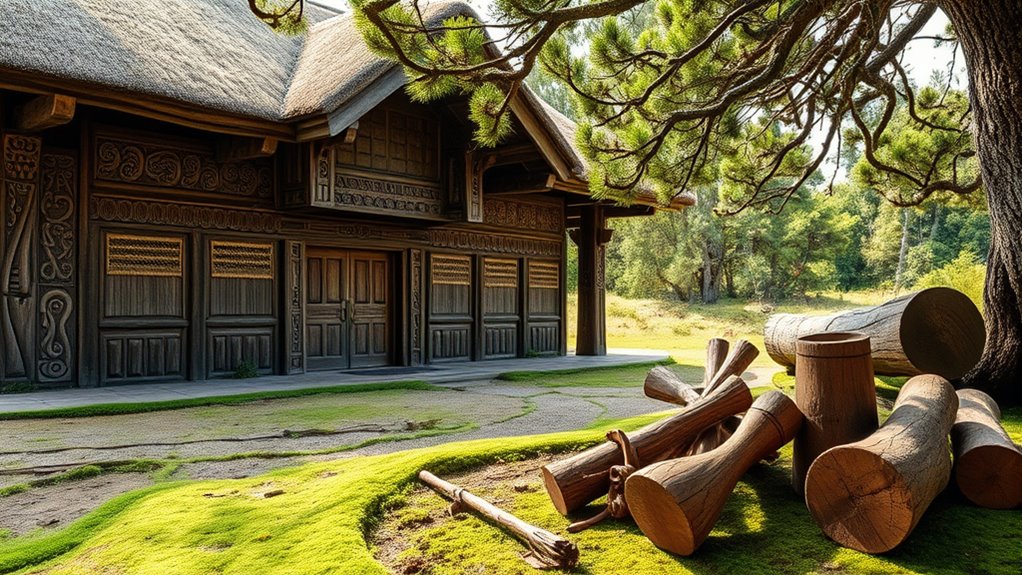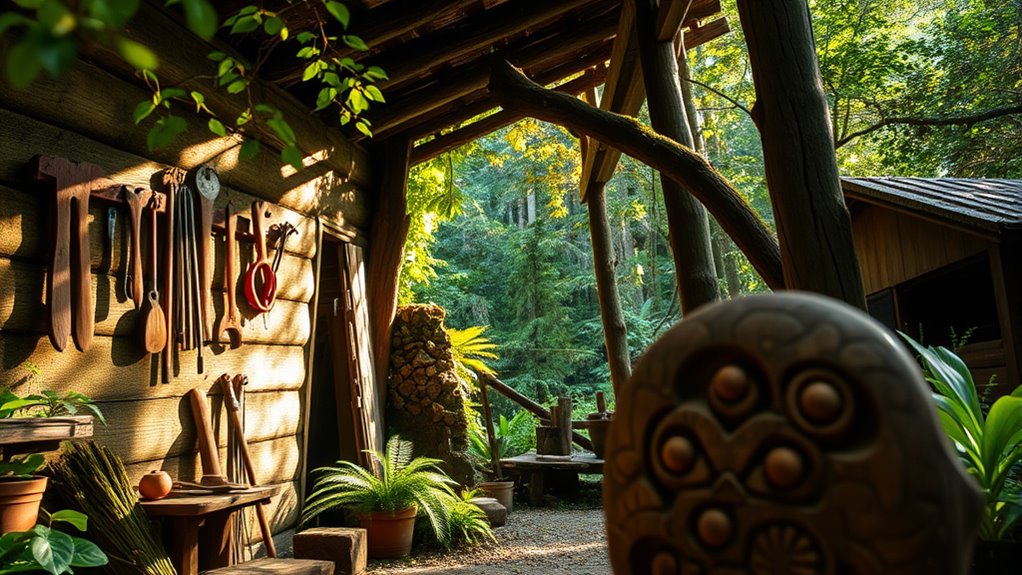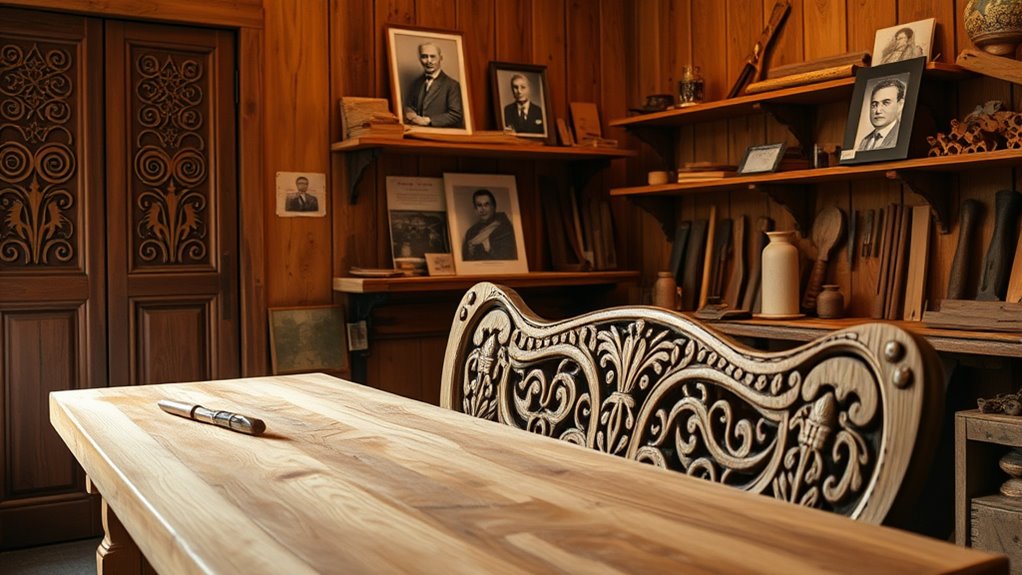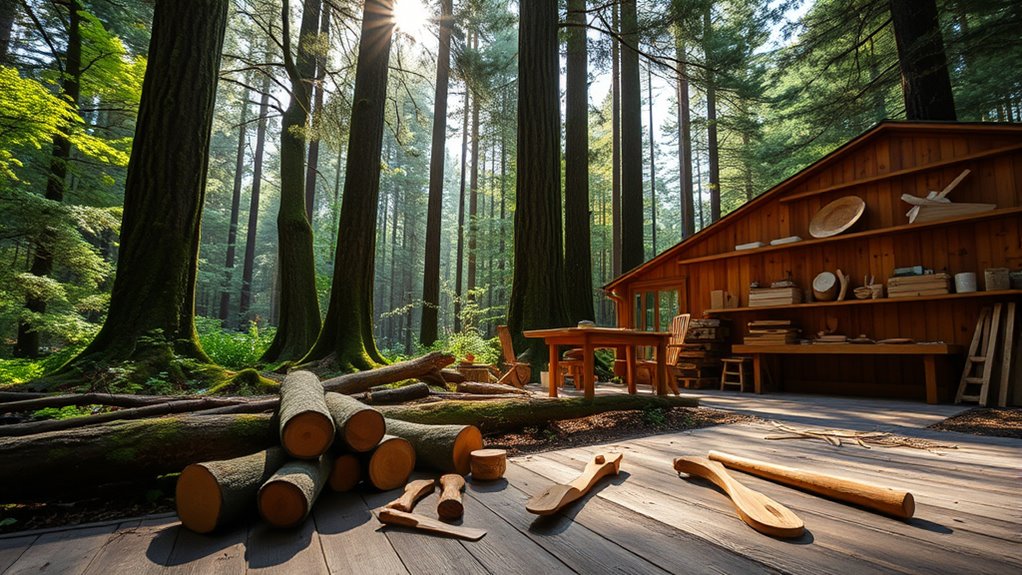The history of woodworking in New Zealand begins with Māori using native woods like ponga and tōtara for carving and building long before European settlers arrived. In the 19th century, the timber industry boomed as native forests like kauri and rimu were logged for ships, furniture, and infrastructure, shaping regional towns and economies. Over time, efforts to conserve forests and develop sustainable practices emerged. If you keep exploring, you’ll uncover how innovation and craftsmanship continue to evolve today.
Key Takeaways
- Māori utilized native woods like ponga, tōtara, and kahikatea for carving, building, and decorative arts before European settlement.
- European settlers relied heavily on native timber, especially kauri and kahikatea, for housing, boats, and furniture from 1840 onward.
- The timber industry expanded with sawmills, tramways, and railways, supporting regional towns and export markets in Britain and Australia.
- Large-scale logging led to forest depletion, ecological damage, and the shift to plantation forestry with species like Pinus radiata.
- Modern woodworking emphasizes sustainable practices, conservation, and the use of native and plantation-grown woods with advanced technology.
Early Use of Native Timber by Māori and Settlers

Long before European settlers arrived, Māori people actively used native timber like ponga, tōtara, and kahikatea for carving, building, and decorative objects. Māori carving techniques showcased their skill with these woods, which were valued for their workability and beauty. When Europeans arrived from 1840, they also relied heavily on native timber, especially kahikatea, for housing, fencing, and railway sleepers due to its abundance and durability. Kauri became highly prized for constructing houses, boats, and furniture because of its light weight and straight grain. Land clearing began as settlers felled native trees using fire and axe to create farmland, often leaving charred stumps. This exploitation of native forests supported the growth of towns and industries, shaping New Zealand’s early development. Additionally, the use of native timber was influenced by sustainable harvesting practices, which aimed to balance resource use with conservation efforts.
The Expansion of the Timber Industry in the 19th Century

After Europeans arrived and began clearing native forests for farmland and settlement, the demand for timber grew rapidly. The timber industry expanded as kauri became the top species for its straight grain and lightness, ideal for building, boats, and furniture. Logging intensified, especially around Native Forests, fueling the growth of sawmills near forests and coastal towns. Railways played a pivotal role, enabling logging operations to reach inland forests and transport timber efficiently. Timber towns sprouted along these routes, supporting the industry’s shift from local use to exporting large quantities to Britain, Australia, and the Pacific. The development of transportation infrastructure, particularly railway lines, was crucial in enabling the industry to access and exploit more remote forest resources efficiently. Additionally, the timber industry faced challenges related to sustainable management as demand increased.
Key Timber Towns and Sawmills in New Zealand

You can see how towns like Otorohanga, Mangapehi, and Waimiha grew around sawmills driven by native forests and railway links. These mills, such as the Mangapehi sawmill built in 1903, became essential processing centers with extensive tramways and locomotives. Today, their history is reflected in heritage sites and routes that commemorate New Zealand’s timber industry. The integration of timber processing techniques and community development played a crucial role in shaping these towns’ identities. Moreover, the contrast ratio in historic mills affected the quality of finished timber, influencing the industry’s development over time. Understanding asset division strategies can also provide insights into how resources and assets were historically allocated within these industrial communities. Additionally, the evolution of wood preservation methods contributed to the durability and value of timber produced in these regions. Recognizing the importance of sustainable forestry practices is vital for the industry’s future resilience.
Historic Timber Towns
Exploring the historic timber towns of New Zealand reveals how communities like Otorohanga, Mangapehi, and Te Kuiti grew around sawmills that processed native bush timber in the early 20th century. These timber towns thrived because of local sawmills, such as the Ellis & Burnand mill established in Mangapehi in 1903, which became a regional hub. The expansion of railway lines played a pivotal role, enabling logs and finished lumber to reach markets and ports efficiently. As the industry shifted toward plantation-grown timber, regional mills at Putaruru and Waimiha emerged, decentralizing timber processing. Today, heritage sites like old tramway routes and abandoned sawmills stand as lasting reminders of these towns’ essential role in New Zealand’s timber industry history. Additionally, the development of timber processing technology contributed to increased production and the growth of these regional communities. The introduction of mechanized sawmilling techniques further revolutionized the industry, boosting efficiency and expanding the scale of operations. Moreover, the adoption of electric-powered machinery marked a significant technological advancement that improved safety and productivity in sawmill operations, aligning with the broader trend of technological progress in the industry. The shift toward plantation forestry also helped sustain the industry as native bush resources became more limited.
Major Sawmill Locations
Major sawmill locations across New Zealand shaped the development of key timber towns and regional industries. Sawmills like those operated by Ellis & Burnand drove growth in towns such as Otorohanga, Mangapehi, and Waimiha, which grew around these processing sites. Extensive tramway networks connected remote forests to regional mills, enabling efficient transport of native timber. In 1903, Ellis & Burnand established the Mangapehi mill, featuring over 14 miles of tramway infrastructure. Hamilton became a hub for their headquarters and sawmill operations after 1904, supporting regional timber processing and export. The Ongarue mill, purchased in 1913 and reopened in 1920, extended into rugged inland forests with 40 km of tramway and produced up to 16 million feet of native timber annually. Coastal and inland towns grew as key regional mills and plantation forestry centers.
The Role of Government Policies and Conservation Efforts

Government policies have played a crucial role in shaping the conservation and management of New Zealand’s native forests. The Forests Acts of 1874 and 1885 established the State Forests Department, aiming to regulate logging and protect forests. Despite these efforts, land clearing for agriculture and timber industries increased, driven by the demand for native timber like kauri and rimu. Export markets from 1840 onward encouraged large-scale logging, with up to 25% of native timber exported between 1890 and 1920. The Kauri Timber Company, founded in 1888, dominated the industry until the early 1900s, leading to significant forest depletion by 1910. Conservation efforts grew in the mid-20th century, resulting in sustainable management practices and the creation of forest reserves. These initiatives reflect a growing awareness of the need to balance resource use with environmental preservation and long-term sustainability. As awareness of ecological impacts increased, policies shifted towards biodiversity conservation and habitat protection to ensure the longevity of native forests for future generations. Additionally, advances in forest management techniques contributed to more effective preservation and regeneration strategies. The development of technology in forestry has also played a vital role in monitoring forest health and implementing sustainable harvesting methods.
Prominent Figures and Their Contributions to Woodcraft

Prominent figures have shaped New Zealand’s woodworking heritage through their craftsmanship and innovation. Johann Martin Levien, a colonial cabinetmaker, promoted native timber internationally and authored *The Woods of New Zealand and Their Adaptability to Art Furniture*, influencing design and appreciation. Anton Seuffert, a Bohemian immigrant, gained fame for his exquisite marquetry work using native timbers like kauri and rimu, leaving a lasting mark on NZ’s woodworking legacy. Ellis and Burnand, established in 1891, became a leading timber company, with key figures like Henry Valder expanding regional mills and advancing the industry. The Seuffert family’s tradition of craftsmanship kept native timber art alive through generations. Today’s artisans, such as Courtney Petley and Levi Borgstrom, continue to emphasize sustainability, innovative design, and traditional techniques, highlighting sustainable practices, while honoring New Zealand’s rich woodcraft history. Additionally, freeze-drying techniques are increasingly explored to preserve and enhance native timbers for artistic purposes, reflecting ongoing innovation in the craft. Furthermore, the integration of traditional techniques with modern technology has allowed artisans to push the boundaries of woodcraft innovation in New Zealand. Moreover, the development of AI-powered tools is opening new possibilities for precision and creativity in woodworking, including the use of modern machinery to achieve intricate designs.
The Impact of Logging on Regional Landscapes and Economy

As logging cleared large areas of native forests, your regional landscapes changed dramatically, leaving lasting scars. The expansion fueled economic growth by creating jobs and boosting related industries, yet it also led to significant forest depletion. Understanding these effects helps you see how industry shaped both the environment and local communities. Additionally, the shift from traditional practices to technological innovations in forestry management has begun to influence sustainable resource use, promoting environmental conservation in the industry.
Forest Depletion Effects
The extensive logging of native trees like kauri during the late 19th and early 20th centuries drastically altered New Zealand’s landscapes, especially in regions such as the Seventy Mile Bush and lower North Island. This widespread logging caused significant forest depletion, reducing native forests and disrupting ecological balance. By 1910, large-scale clearances had diminished biodiversity and weakened ecosystems. The collapse of native timber supplies challenged regional economies, forcing industries to adapt or decline. To address this, plantation forestry, especially radiata pine, grew in importance. The table below highlights the shift from native forest reliance:
| Aspect | Before Logging | After Logging | Current Focus |
|---|---|---|---|
| Native forests | Abundant and biodiverse | Depleted and fragmented | Conservation efforts |
| Timber industry | Dependent on native trees | Shift to plantations | Sustainable management |
| Ecological impact | Ecosystem disruption | Loss of biodiversity | Restoration initiatives |
| Forest depletion | Minimal | Significant | Reforestation policies |
| Regional economy | Stable | Challenged, industry decline | Diversification |
Economic Growth Drivers
Logging during the late 19th and early 20th centuries ignited a surge of economic growth across New Zealand’s regions by establishing sawmills and creating jobs for thousands. The native timber industry, especially kauri and rimu, became a essential driver of regional economies. Extensive timber transport networks, including tramways and railways, enabled rapid extraction and movement of logs from forests to markets. Peak logging around 1905 saw over 573 million feet of native timber produced annually, fueling local industries and infrastructure. Land clearing transformed landscapes into timber towns, supporting communities and boosting regional trade. Although conservation policies emerged, the high demand for native timber kept land clearing and resource exploitation at the forefront, solidifying the logging industry’s role as a key economic growth driver.
Regional Landscape Changes
Extensive logging of native forests, especially kauri, around 1905 dramatically transformed the regional landscapes of Northland and Coromandel. As logging intensified, large areas of native forests were cleared, causing significant landscape changes and disrupting regional ecosystems. Kauri timber, highly valued, fueled these practices, but overharvesting led to deforestation and ecological decline. The development of railways from 1908 expanded logging into inland districts like Rangitīkei, Waimarino, and Taupō, creating timber towns that reshaped local economies and settlements. As high-quality native timber became scarce, forest management shifted towards plantation forestry with Pinus radiata from the 1910s, gradually replacing native forests and permanently altering the regional landscape.
Contemporary Approaches to Sustainable Timber Use

Contemporary New Zealand woodworkers embrace sustainable timber use by prioritizing materials that minimize environmental impact, such as salvaged, donated, or locally sourced woods. You’re encouraged to focus on native forests and plantation-grown woods managed through responsible resource management schemes like FSC. To reduce waste and guarantee the best use, artisans utilize techniques such as kiln-drying and controlled harvesting. Key practices include:
- Selecting fast-growing species like Pinus radiata to lessen pressure on native forests.
- Supporting certification schemes such as FSC and PEFC to promote sustainable forestry.
- Using non-toxic finishes and natural oils to reduce chemical emissions and preserve timber quality.
These approaches help balance craftsmanship with environmental stewardship, fostering a sustainable future for woodworking in New Zealand.
Frequently Asked Questions
What Is the Origin of Woodworking?
You might wonder about the origin of woodworking, and it all starts with early humans using tools and natural materials to create objects. Over time, you see, they learned to carve, shape, and assemble wood for practical needs. This skill evolved across cultures, blending tradition and innovation, eventually becoming a essential craft for building, artistry, and cultural expression. Your curiosity connects to a long history of human ingenuity with wood.
What Is Timber Used for in New Zealand?
Timber in New Zealand serves many purposes. You’ll find it used for building houses, furniture, boats, and fencing, thanks to native woods like kauri, rimu, mataī, and totara. It’s also indispensable for infrastructure, such as railway sleepers and wharfs, supporting settlement and trade. Plus, you use local timbers for firewood, small domestic objects, and even export them to other countries, playing a crucial role in the economy and daily life.
How Has Woodworking Evolved Over Time?
They say change is the only constant, and woodworking in New Zealand proves it. Over time, you’ve seen it shift from utilitarian uses with native timbers to artistic expressions, incorporating Māori motifs and natural themes. You’ve embraced new tools and techniques, like marquetry and ornamental turning, while also prioritizing sustainability. Today, you combine tradition with innovation, reflecting a craft that evolves yet stays true to its roots.
Is Woodworking a Craft?
Yes, woodworking is a craft because it involves skillful, hands-on techniques to create both functional and decorative objects from wood. You actively use traditional methods and precise tools, emphasizing aesthetic details. It’s more than just making things; it’s about blending artistic expression with technical skill. Your craftsmanship reflects cultural influences and personal creativity, making each piece unique and rooted in a rich history of skilled handiwork.
Conclusion
As you explore New Zealand’s rich woodworking history, picture lush forests giving way to bustling timber towns, their echoes of saws and chippers shaping the land. Today, sustainable practices help preserve these ancient forests, ensuring future generations can walk through groves where native trees once thrived. By respecting this heritage, you become part of a story where craftsmanship and nature intertwine, safeguarding the beauty of New Zealand’s landscape for years to come.








